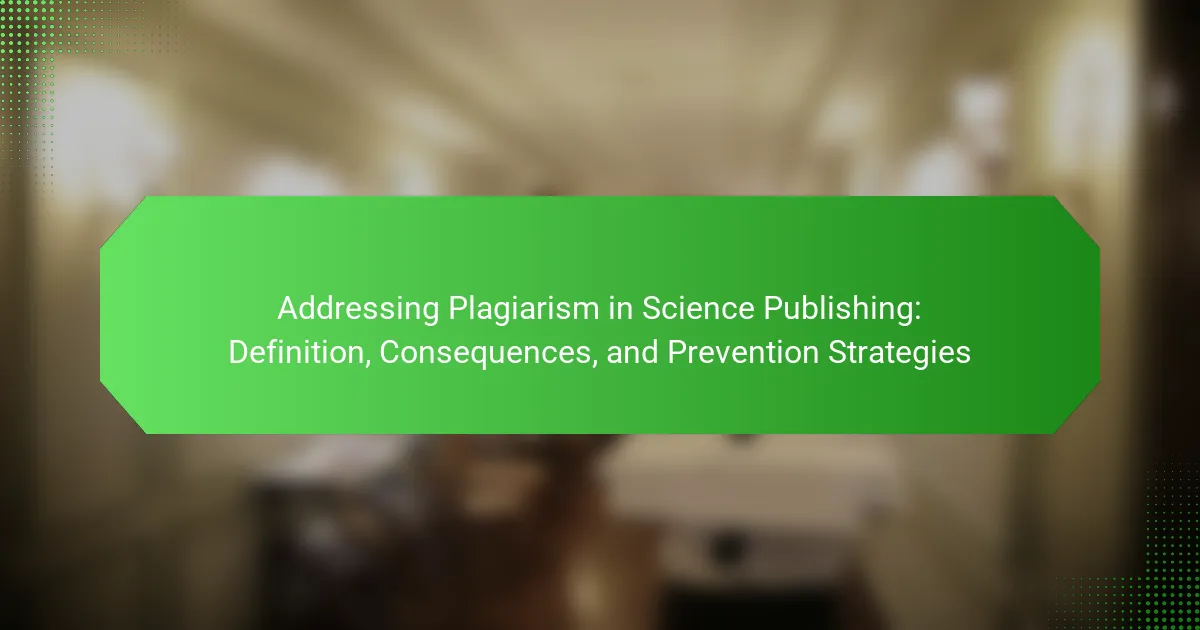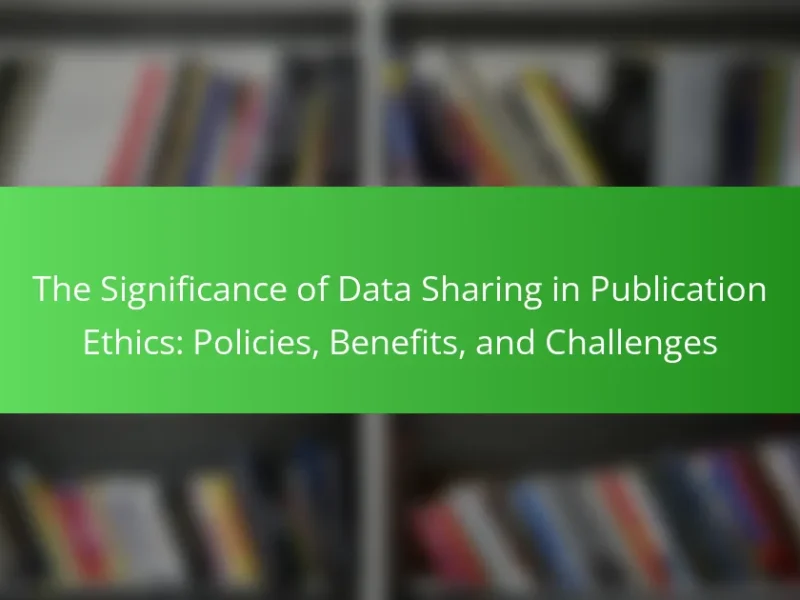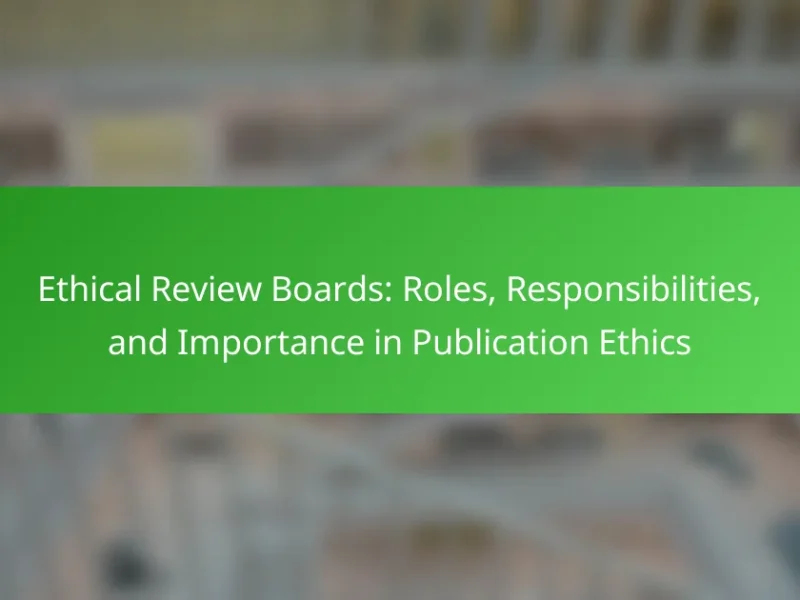Plagiarism in science publishing refers to the unethical practice of using another author’s work or ideas without proper attribution, which can include copying text, data, or images. This practice undermines the integrity of scientific research and can result in severe consequences, such as the retraction of published papers and harm to the author’s reputation. The article outlines the significance of plagiarism in academic publishing, as highlighted by the Committee on Publication Ethics (COPE), and emphasizes the importance of understanding and avoiding plagiarism to maintain credibility. It also discusses various prevention strategies, including rigorous peer review processes, the use of plagiarism detection software, and the education of researchers on proper citation practices. Additionally, best practices for ethical writing in science publishing are presented, focusing on honesty, transparency, and collaboration to uphold the integrity of scientific literature.
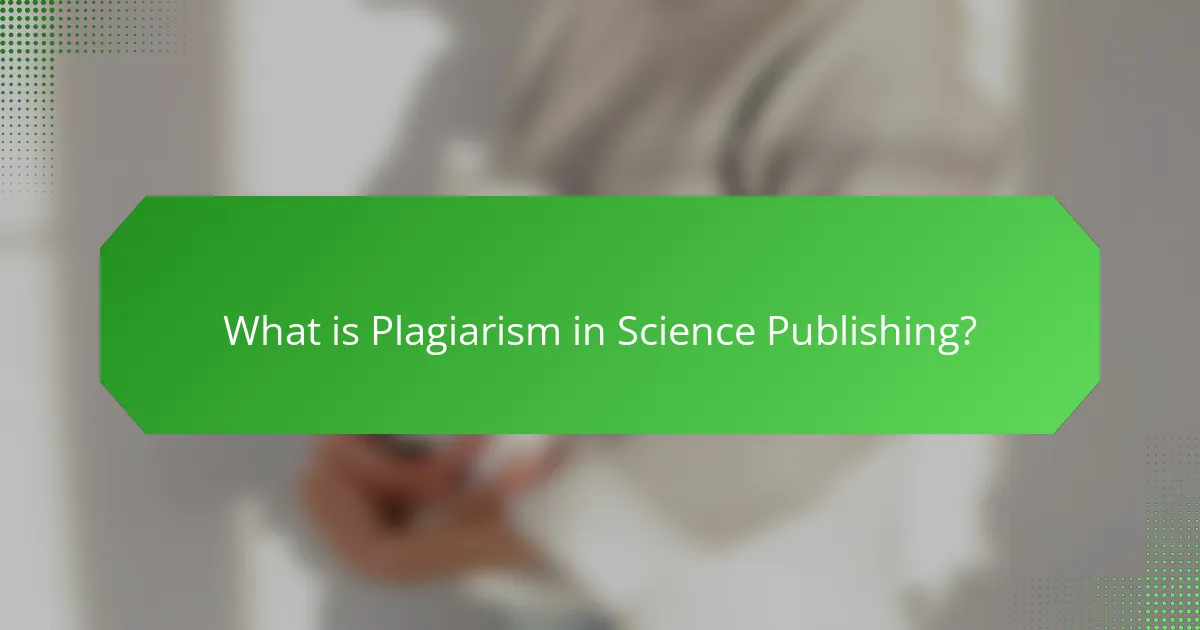
What is Plagiarism in Science Publishing?
Plagiarism in science publishing is the unethical practice of using someone else’s work or ideas without proper attribution. This includes copying text, data, or images from other authors without permission. Plagiarism undermines the integrity of scientific research. It can lead to serious consequences, such as retraction of published papers and damage to the author’s reputation. According to the Committee on Publication Ethics (COPE), plagiarism is a significant concern in academic publishing. It is essential for researchers to understand and avoid plagiarism to maintain credibility in their field.
How is plagiarism defined within the context of scientific research?
Plagiarism in scientific research is defined as the unethical practice of using someone else’s work, ideas, or expressions without proper attribution. This includes copying text, data, or images from published sources. It also encompasses self-plagiarism, where authors reuse their own previously published work without acknowledgment. The integrity of scientific research relies on originality and transparency. According to the Committee on Publication Ethics (COPE), plagiarism undermines the credibility of research and can lead to serious consequences. These consequences may include retraction of published papers, damage to the author’s reputation, and legal repercussions.
What are the different types of plagiarism that can occur in scientific publishing?
The different types of plagiarism that can occur in scientific publishing include direct plagiarism, self-plagiarism, mosaic plagiarism, and accidental plagiarism. Direct plagiarism involves copying text verbatim from another source without proper citation. Self-plagiarism occurs when an author reuses their previously published work without acknowledgment. Mosaic plagiarism, also known as patchwork plagiarism, involves piecing together text from various sources without proper attribution. Accidental plagiarism happens when authors unintentionally fail to cite sources or misquote them. These types of plagiarism undermine the integrity of scientific research and can lead to serious consequences, including retraction of published papers and damage to an author’s reputation.
Why is it important to understand the definition of plagiarism in science?
Understanding the definition of plagiarism in science is crucial for maintaining academic integrity. Plagiarism undermines the credibility of scientific research. It can result in severe consequences such as retraction of published papers and damage to professional reputations. Additionally, understanding plagiarism helps researchers to properly attribute ideas and data to their original sources. This practice fosters a culture of respect and collaboration within the scientific community. According to the Committee on Publication Ethics, proper citation practices are essential for transparency and trust in research. Awareness of plagiarism definitions also aids in educating new researchers about ethical standards. Overall, grasping this concept is fundamental for the advancement of knowledge and innovation in science.
What are the consequences of plagiarism in science publishing?
Plagiarism in science publishing leads to severe academic consequences. It can result in retraction of published papers. Authors may face loss of credibility and professional reputation. Institutions may impose disciplinary actions, including termination. Funding opportunities can be jeopardized due to ethical violations. Legal consequences may arise from copyright infringement. Journals often blacklist plagiarizing authors, limiting future publication chances. Research integrity is compromised, affecting the scientific community’s trust. These consequences highlight the importance of originality in scientific work.
How does plagiarism impact the integrity of scientific research?
Plagiarism undermines the integrity of scientific research by misrepresenting original ideas and contributions. It creates a false impression of knowledge and expertise. This erosion of trust can lead to skepticism about published findings. Researchers rely on the credibility of their peers to advance science. When plagiarism occurs, it damages the collaborative spirit essential for innovation. Studies show that a significant percentage of researchers have encountered plagiarism in their fields. This prevalence highlights the need for stringent ethical standards. Ultimately, plagiarism compromises the foundation upon which scientific progress is built.
What are the potential legal repercussions for authors found guilty of plagiarism?
Authors found guilty of plagiarism may face several legal repercussions. These can include civil lawsuits for copyright infringement. Such lawsuits can result in substantial financial penalties. Authors might also be ordered to pay damages to the original author. Additionally, institutions may impose disciplinary actions, including expulsion or termination. Legal repercussions can also lead to loss of reputation in the academic community. This can hinder future publication opportunities and funding prospects. Plagiarism can also result in retraction of published works. These consequences underscore the seriousness of maintaining academic integrity.
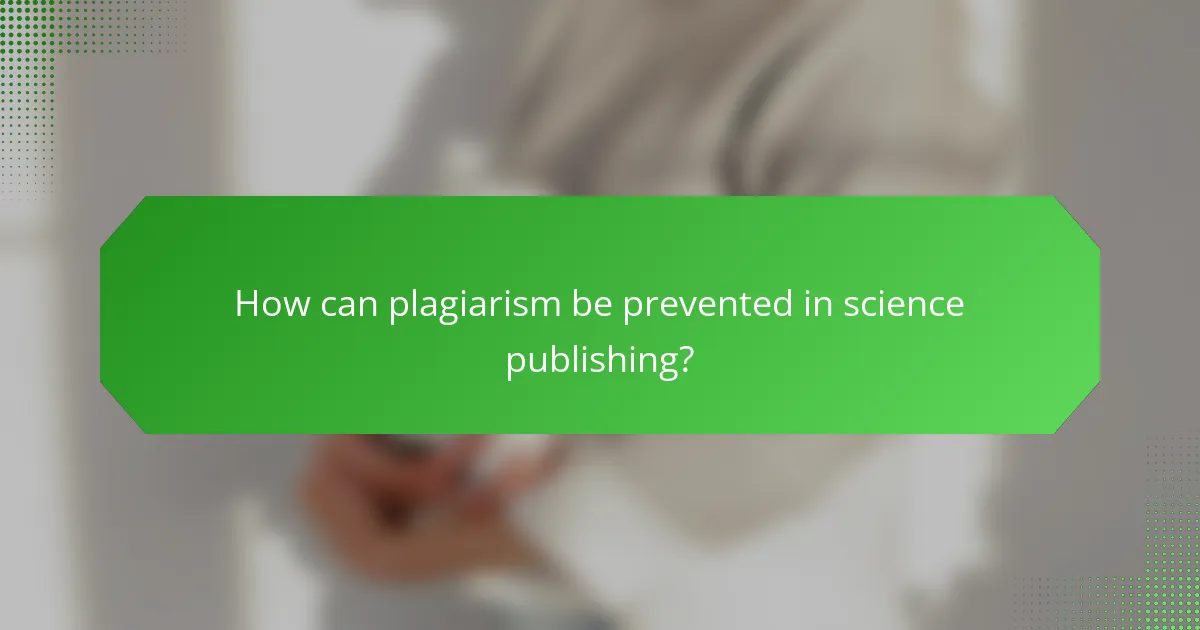
How can plagiarism be prevented in science publishing?
Plagiarism in science publishing can be prevented through several strategies. Implementing rigorous peer review processes helps identify potential plagiarism before publication. Utilizing plagiarism detection software can effectively highlight similarities with existing literature. Educating researchers about proper citation practices is crucial for fostering integrity. Establishing clear guidelines for authors regarding originality requirements is essential. Encouraging transparency in the research process can also deter unethical practices. Regular workshops on ethical publishing practices can enhance awareness among scientists. These measures collectively promote a culture of honesty and accountability in scientific research.
What strategies can researchers implement to avoid plagiarism?
Researchers can implement several strategies to avoid plagiarism. They should always properly cite sources for any ideas, quotes, or data that are not their own. Using plagiarism detection software can help identify unintentional similarities with existing literature. Maintaining detailed notes during research can clarify which ideas are original and which are sourced. Paraphrasing effectively is crucial; it requires rephrasing ideas in one’s own words while still giving credit to the original author. Understanding the specific citation style required for their field is essential for accurate referencing. Additionally, collaborating with peers for feedback can provide insights on proper attribution practices. Engaging in training on academic integrity can further reinforce the importance of avoiding plagiarism. These strategies collectively promote ethical research practices and uphold the integrity of scientific publishing.
How can proper citation practices help prevent plagiarism?
Proper citation practices help prevent plagiarism by clearly attributing ideas and information to their original sources. This transparency allows readers to trace the origins of content. When authors cite sources, they acknowledge the contributions of others. This acknowledgment reduces the likelihood of unintentional plagiarism. Studies show that proper citation increases academic integrity. For instance, a 2018 study published in the Journal of Academic Ethics found that students who received training in citation practices reported fewer instances of plagiarism. Thus, effective citation practices serve as a safeguard against both intentional and unintentional plagiarism.
What role does education play in reducing instances of plagiarism?
Education plays a crucial role in reducing instances of plagiarism. It fosters an understanding of academic integrity and the importance of original work. Through education, students learn how to properly cite sources and give credit to original authors. This knowledge decreases the likelihood of unintentional plagiarism. Educational programs also emphasize the consequences of plagiarism, reinforcing its seriousness. Research indicates that institutions with strong academic integrity policies see lower rates of plagiarism. For example, a study published in the “Journal of Academic Ethics” found that educational interventions significantly reduced plagiarism among students. Overall, effective education creates a culture of honesty and respect for intellectual property.
What tools and resources are available for detecting plagiarism?
Plagiarism detection tools and resources include software programs and online services. Popular tools are Turnitin, Grammarly, and Copyscape. Turnitin is widely used in academic institutions for checking student submissions. Grammarly offers a plagiarism checker alongside grammar and style suggestions. Copyscape is commonly used for web content to identify duplicate content. These tools compare texts against extensive databases and web pages. They provide reports highlighting potential plagiarism instances. Many academic journals also utilize proprietary plagiarism detection systems. These resources help maintain integrity in scientific publishing.
How effective are plagiarism detection software tools in academic publishing?
Plagiarism detection software tools are highly effective in academic publishing. These tools analyze texts for similarities against vast databases of published works. They can identify both direct copying and paraphrased content. Studies show that tools like Turnitin and Grammarly can detect over 90% of plagiarism cases. Their algorithms continuously improve, adapting to new writing styles and sources. Many academic journals require submissions to pass plagiarism checks before publication. This requirement helps maintain integrity in research and scholarship. Overall, plagiarism detection software significantly contributes to upholding academic standards.
What is the role of peer review in identifying and preventing plagiarism?
Peer review plays a crucial role in identifying and preventing plagiarism in academic publishing. It involves the evaluation of a manuscript by experts in the field before publication. Reviewers assess the originality of the work and check for proper citations. They can identify similarities with existing literature that may indicate plagiarism. Additionally, peer reviewers often recommend the use of plagiarism detection software. This software scans manuscripts for unoriginal content, further safeguarding the integrity of scientific publishing. Studies show that rigorous peer review reduces instances of plagiarism. Consequently, it enhances the credibility of published research.
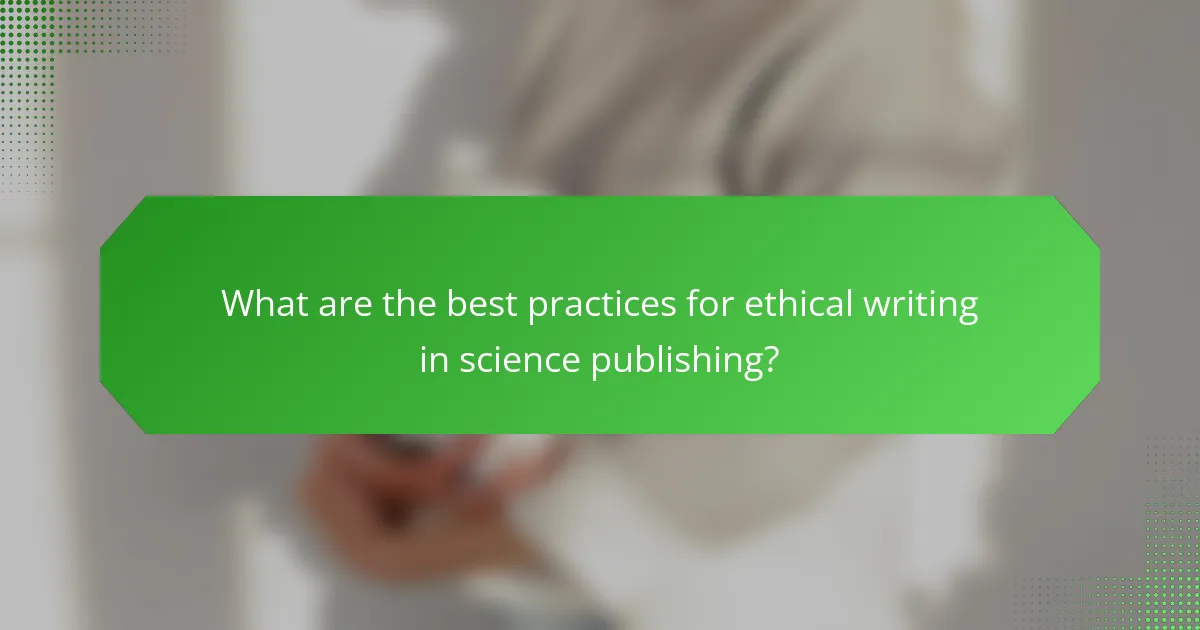
What are the best practices for ethical writing in science publishing?
Best practices for ethical writing in science publishing include maintaining honesty and integrity. Authors must ensure that all claims are supported by evidence. Proper citation of sources is essential to avoid plagiarism. Transparency in methodology enhances credibility. Collaboration should be conducted respectfully and fairly. Authors must disclose conflicts of interest when applicable. Peer review processes should be adhered to rigorously. These practices are vital for upholding the integrity of scientific literature.
How can researchers ensure originality in their work?
Researchers can ensure originality in their work by conducting thorough literature reviews. This process helps identify existing research and gaps in knowledge. Additionally, utilizing plagiarism detection software can highlight similarities with published works. Maintaining detailed notes during research is crucial for tracking ideas and sources. Researchers should also engage in discussions with peers to refine their concepts. Furthermore, proper citation practices are essential to give credit to original ideas. By following these strategies, researchers can create unique contributions to their fields.
What are the benefits of maintaining a research diary or notes?
Maintaining a research diary or notes enhances organization and clarity in the research process. It allows researchers to document ideas, observations, and progress systematically. This practice fosters critical thinking by encouraging reflection on research methods and outcomes. A well-kept diary aids in tracking sources and citations, reducing the risk of unintentional plagiarism. Furthermore, it serves as a personal record that can be referenced for future studies or publications. The act of writing also reinforces memory retention, making it easier to recall important details later. Overall, research diaries promote accountability and integrity in scientific work.
How can collaborative work be managed to avoid plagiarism?
Collaborative work can be managed to avoid plagiarism by establishing clear guidelines and expectations. Each participant should understand the importance of original contributions. Regular communication fosters transparency about individual inputs. Utilizing collaborative tools with version control can track changes and authorship. Conducting periodic reviews helps identify potential overlaps in content. Educating team members on citation practices is essential. Implementing plagiarism detection software can catch unintentional similarities. These strategies collectively promote integrity in collaborative projects.
What are common misconceptions about plagiarism in science publishing?
Common misconceptions about plagiarism in science publishing include the belief that only verbatim copying constitutes plagiarism. In reality, paraphrasing without proper citation also qualifies as plagiarism. Another misconception is that self-plagiarism is acceptable. However, reusing one’s own previously published work without acknowledgment can lead to ethical violations. Many also think that plagiarism detection software catches all instances of plagiarism. In truth, these tools may miss nuanced cases or improperly formatted citations. Additionally, some believe that plagiarism is a minor issue in scientific publishing. Research shows that it can severely damage a researcher’s reputation and career. Lastly, some assume that plagiarism only affects the author. However, it can also impact the credibility of the entire research community and the integrity of published work.
Why do some researchers believe that self-plagiarism is acceptable?
Some researchers believe that self-plagiarism is acceptable because it can enhance the dissemination of knowledge. They argue that reusing one’s own previously published work can reinforce key findings. This practice may ensure that important information reaches broader audiences. Additionally, researchers may contend that self-plagiarism does not harm the academic integrity of the work. In some cases, they feel that it is necessary for clarity and consistency in related publications. According to a study by P. A. R. M. Smith (2018), self-plagiarism can sometimes be viewed as a tool for effective communication rather than a violation of ethical standards.
How can understanding these misconceptions help improve ethical writing?
Understanding misconceptions about plagiarism can significantly enhance ethical writing. Misconceptions often lead to unintentional plagiarism. Clarifying these misconceptions helps writers recognize proper citation practices. It also encourages original thought and research integrity. For instance, many believe that common knowledge does not require citation. This misunderstanding can result in uncredited ideas, which is unethical. Educating writers on what constitutes plagiarism fosters accountability. It promotes a culture of respect for intellectual property. Improved awareness directly correlates with reduced instances of unethical writing.
What practical tips can researchers follow to uphold integrity in their writing?
Researchers can uphold integrity in their writing by ensuring proper citation of sources. This includes giving credit to original authors for their ideas and findings. Maintaining transparency about research methods and data is essential. Researchers should disclose any potential conflicts of interest that may influence their work. They must also avoid self-plagiarism by not reusing their previous work without acknowledgment. Engaging in peer review helps identify potential issues before publication. Utilizing plagiarism detection software can further safeguard against unintentional misconduct. Following these practices contributes to the overall credibility of scientific literature.
Plagiarism in science publishing refers to the unethical practice of using another’s work or ideas without proper attribution, including direct copying and self-plagiarism. The article outlines the various types of plagiarism, the significant consequences it can have on authors and the scientific community, and the importance of understanding and preventing such unethical practices. It discusses strategies for avoiding plagiarism, such as proper citation, utilizing detection tools, and fostering educational initiatives to promote academic integrity. Additionally, the article addresses common misconceptions about plagiarism and emphasizes the need for ethical writing practices in scientific research.
